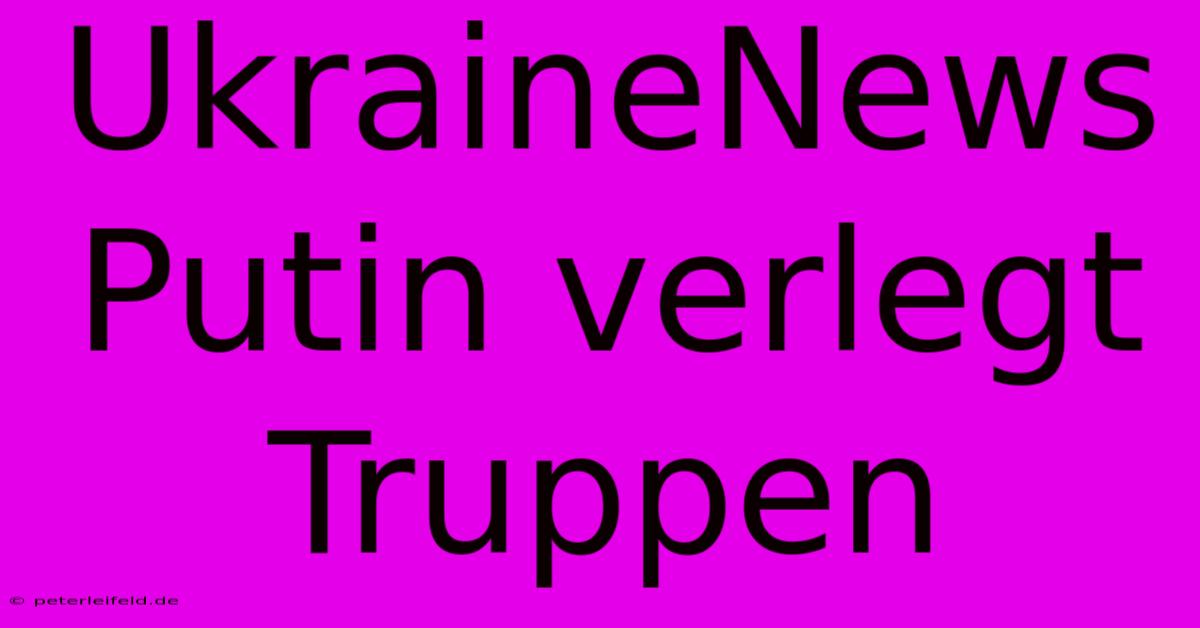UkraineNews Putin Verlegt Truppen

Discover more detailed and exciting information on our website. Click the link below to start your adventure: Visit Best Website UkraineNews Putin Verlegt Truppen. Don't miss out!
Table of Contents
Ukraine News: Putin Shifts Troops – What Does It All Mean?
Hey everyone, let's talk about something seriously heavy: Putin's troop movements in Ukraine. This is a super complex situation, and honestly, I'm no expert. But I've been following this closely, reading news from sources like the BBC, Reuters, and even some Ukrainian blogs – trying to piece together what's happening. And I wanna share what I've picked up, along with some of my own – let's be honest, sometimes totally clueless – thoughts.
I'll admit, at first, I was completely overwhelmed. So many news reports, so many conflicting opinions. It felt like trying to assemble a giant jigsaw puzzle with half the pieces missing. I remember one particularly frustrating evening, scrolling endlessly, feeling more confused than ever. I almost gave up. But then I thought, "Hey, if I'm this lost, there must be others out there who need some clarity." So, I decided to try and break it all down in a way that's easier to understand.
Understanding Putin's Troop Movements
The headlines scream "Putin verlegt Truppen," which basically means Putin is repositioning his troops. But where he's moving them and why is the million-dollar question. Some analysts suggest it's a defensive maneuver, strengthening existing positions. Others think it's a prelude to a new offensive, maybe targeting the east or south. Honestly? I'm not sure. There's a lot of speculation.
What I have learned is that analyzing satellite imagery, military intelligence reports, and statements from various governments (even if they contradict each other sometimes!) is key to understanding these shifts. It's like detective work, piecing together tiny clues to build a bigger picture.
The Importance of Reliable News Sources
This leads me to a crucial point: reliable sources are EVERYTHING. It’s super easy to get caught up in misinformation, especially online. Sticking to reputable news organizations and fact-checking websites helps you avoid falling down a rabbit hole of false narratives.
My Personal Misinformation Mistake
I'll confess, early on, I fell for a fake news story about a massive Ukrainian victory. I felt a huge surge of hope... only to be crushed a few hours later when it turned out to be totally bogus. That taught me a valuable lesson: always double-check your sources. No matter how much you want a particular narrative to be true, verifying it is essential.
What to Look For in Reliable News Sources
- Fact-checking: Look for sources that cite their evidence and show their methodology clearly.
- Multiple Perspectives: Read news from multiple sources to get a wider view of events.
- Reputable Organizations: Focus on respected news outlets with a history of unbiased reporting.
- Be Wary of Sensationalism: Sensational headlines often mask bias or inaccuracies.
The Broader Geopolitical Context
Understanding the troop movements requires looking at the bigger picture. The war in Ukraine is deeply intertwined with complex geopolitical issues, involving NATO, the EU, and global energy markets. These connections aren't always immediately obvious, but they're critical to comprehending the situation's nuances.
Staying Informed – But Protecting Your Mental Health
Following this conflict closely is important, but it can also be emotionally draining. It's okay to take breaks from the news, especially if you find yourself feeling overwhelmed or anxious. Finding healthy coping mechanisms – talking to friends, spending time in nature, or engaging in hobbies – is crucial.
Ultimately, the situation in Ukraine is dynamic and full of uncertainty. Putin's troop movements are only one piece of a much larger puzzle. By relying on credible sources, thinking critically, and taking care of our own mental well-being, we can navigate these difficult times with more clarity and understanding. Remember to stay safe, stay informed, and take care of yourselves.

Thank you for visiting our website wich cover about UkraineNews Putin Verlegt Truppen. We hope the information provided has been useful to you. Feel free to contact us if you have any questions or need further assistance. See you next time and dont miss to bookmark.
Featured Posts
-
F1 Crash Las Vegas Bilder
Nov 23, 2024
-
Xrp Ada Altcoin Preisanstieg Ursachen
Nov 23, 2024
-
Colturi Unterliegt Shiffrin In Gurgl
Nov 23, 2024
-
Skisprung Leidenschaft Lebt
Nov 23, 2024
-
Altcoin Kursentwicklung Xrp Ada Analyse
Nov 23, 2024
